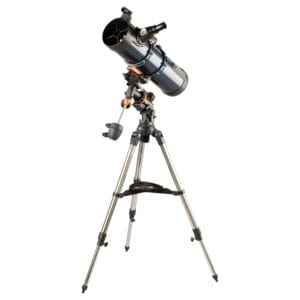Stargazing isn’t necessarily a hobby you come across often. This is largely because people think it’s a complicated hobby. While the complexity is still there, it’s becoming increasingly accessible for beginners to make an “easy” start.
Telescopes have undergone an enormous evolution over the centuries, from simple lenses to advanced technologies that let us explore the universe to its farthest corners. Today’s modern telescopes are not only more powerful but also much more user-friendly and versatile than ever before. Innovations such as AI technology, automated search functions, and mobile connectivity make stargazing accessible to everyone, from beginning enthusiasts to seasoned astronomers. In this article, you’ll discover the latest trends and innovations that are shaping the future of telescopes.
1. AI and Automation: Smart Telescopes
One of the biggest innovations is the integration of AI in telescopes. Smart telescopes can now automatically align themselves and even recognize stars and planets. This is a game-changer for beginners, as searching for specific stars or planets no longer needs to be done manually. An example of this is the AI-driven Finder TW2, which helps beginners and advanced users quickly find objects in the night sky.
AI enables users to make complex observations with minimal effort and even offers image optimizations that improve brightness and detail. This not only enriches the experience but also offers new possibilities for astrophotography, making photos of deep-sky objects like galaxies and nebulae sharper.
2. Improved Image Quality through Advanced Sensors
The image quality of telescopes has improved drastically in recent years, especially through the use of advanced sensors such as CMOS and CCD sensors. These are the same sensors used in professional cameras, but in telescopes, they provide crystal-clear images of the night sky. For astrophotographers, this means that even smaller, portable telescopes can now capture impressive images.
Thanks to these sensors, the costs of high-end equipment are becoming more accessible, opening up the market for amateur astronomers who want more than just observation. Many brands, such as StellarVision, now offer affordable telescopes with high-quality sensors that are user-friendly and ideal for home use.
3. Portability and Design: Telescopes for Home and Travel
Another notable trend is the development of portable telescopes that are easy to take with you. With lightweight but robust materials, it’s now possible to make powerful telescopes that are still manageable. These portable models, often including tripod and carrying case, are ideal for people who want to stargaze in remote locations without much light pollution, such as nature reserves or mountainous areas.
For beginners and people who mainly observe from home, there are also compact telescopes that can be placed on a balcony or in a garden without compromising image quality. The rise of lightweight and easy-to-set-up telescopes makes stargazing more accessible to everyone.
4. Light Pollution Technology: Better View of the Night Sky
Light pollution is a well-known problem when observing the night sky. Manufacturers are working on technologies to reduce its impact. Think of filters that block light pollution or special coatings that block ambient light. This provides a better and clearer viewing experience, even in urban areas. Innovations in this area give users a clearer view without having to travel to remote locations.
Additionally, telescopes are appearing with built-in light filters that automatically adjust based on lighting conditions. This makes it easier to enjoy the same telescope in different environments without having to make manual adjustments.
5. the Smartphone in Combination with the Telescope
A trend that’s becoming increasingly popular is the ability to connect the telescope to a smartphone or tablet. Using apps, users can directly control telescopes and save objects for later observation. This kind of technology is particularly attractive to beginners, who can learn to navigate faster and learn more about the night sky.
Apps often provide additional information about the objects being observed, such as details about planets, constellations, and deep-sky objects. For families with children, this can be a fun way to learn about the cosmos together and develop new hobbies.
6. Innovative Mounting Systems for Better Stability
Stability is crucial when observing and photographing the night sky. The new generation of telescopes uses innovative mounting systems, such as alt-azimuth mounts and GoTo mounts. These types of systems make it easier to track objects in the sky and provide a more stable image, which is especially useful when using higher magnifications.
Mounts with built-in motors and automation ensure that telescopes can easily track the movements of stars and planets, allowing you to observe longer without making manual adjustments.
7. Telescopes for Specific User Groups
Where telescopes used to often have a universal design, more models are now emerging aimed at specific users. Think of child-friendly telescopes with simple controls and lightweight materials, or professional telescopes with high resolution for scientific research. There are also specialized telescopes for astrophotography with features such as high ISO sensitivity and extra accessories for capturing images.
These user-specific models ensure that everyone, regardless of experience or area of interest, can enjoy stargazing and observing the universe.
Conclusion
The future of telescopes is versatile and exciting, with innovations making telescopes increasingly accessible and more advanced. Whether you’re a beginner wanting to start stargazing easily, or an experienced astrophotographer looking for the latest features, the technological developments within the telescope industry offer something for everyone. From AI to portability and improved image quality, these trends make it possible to experience the cosmos in a completely new way.








